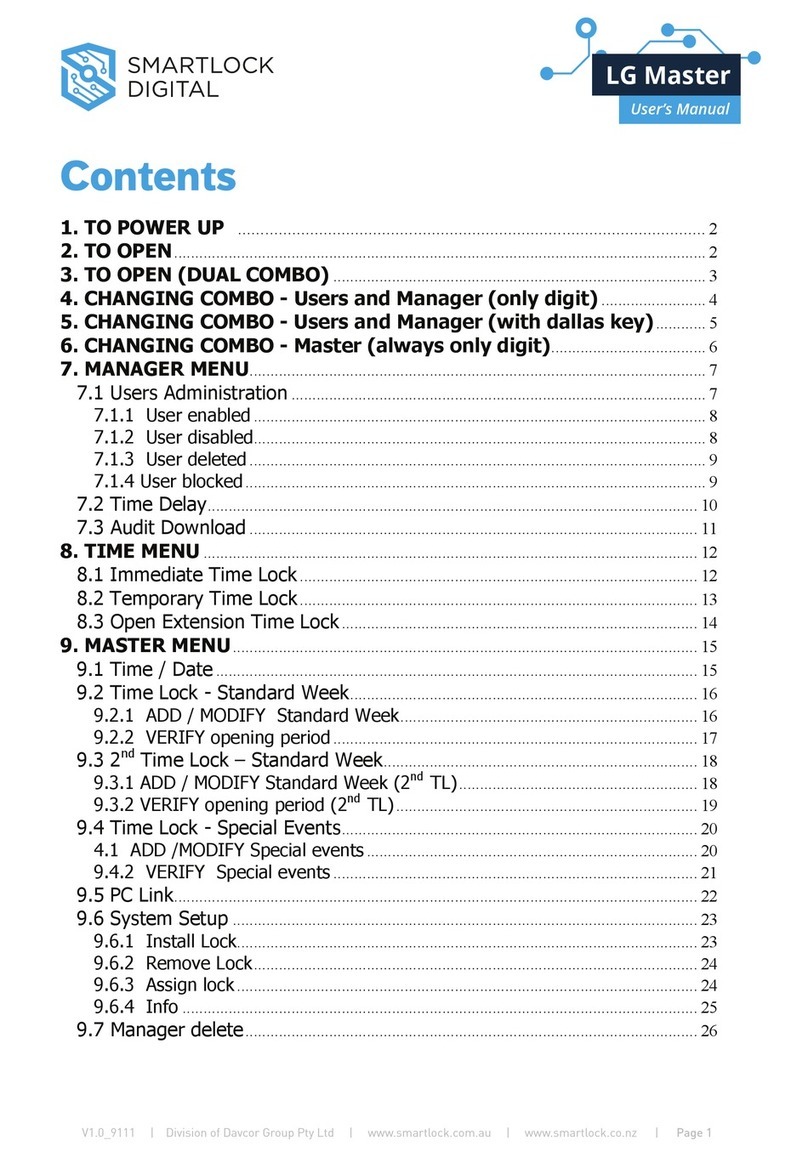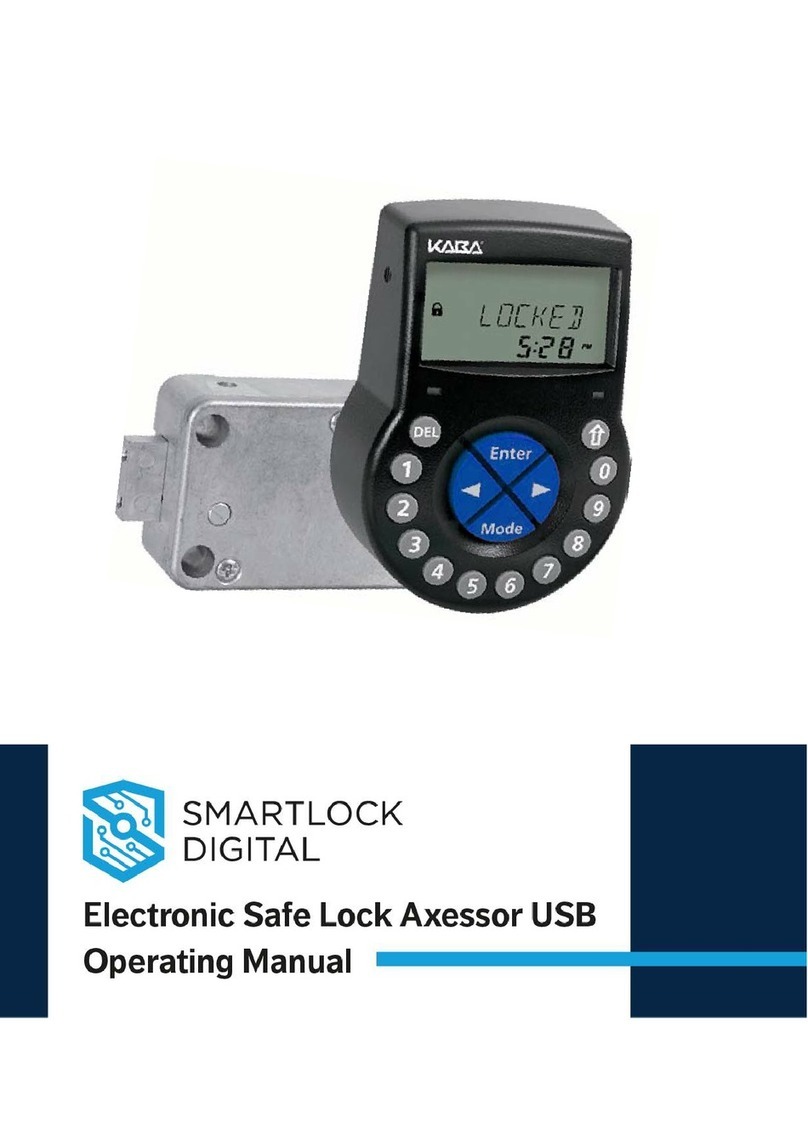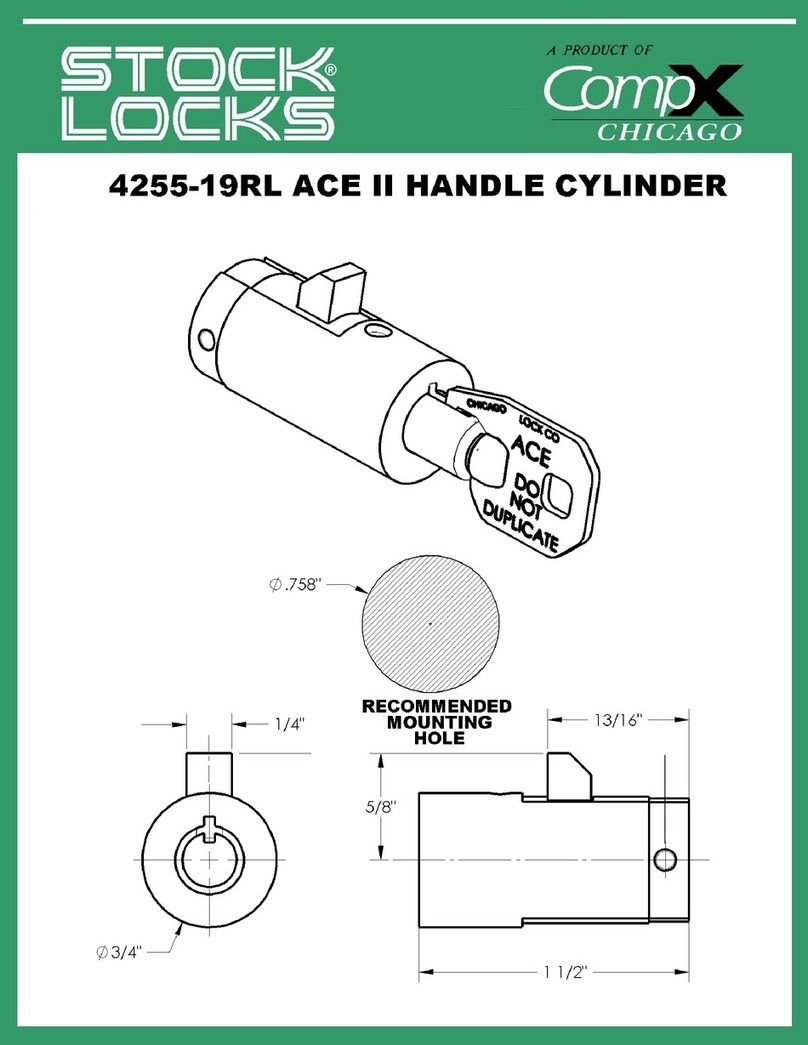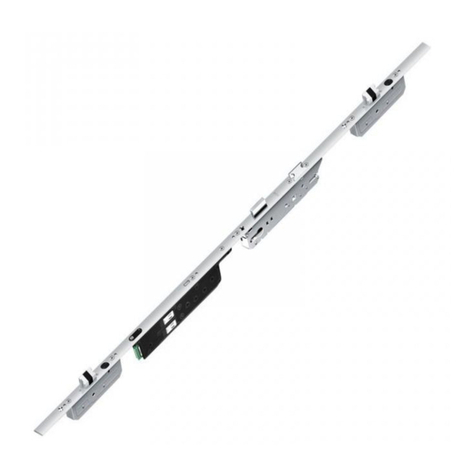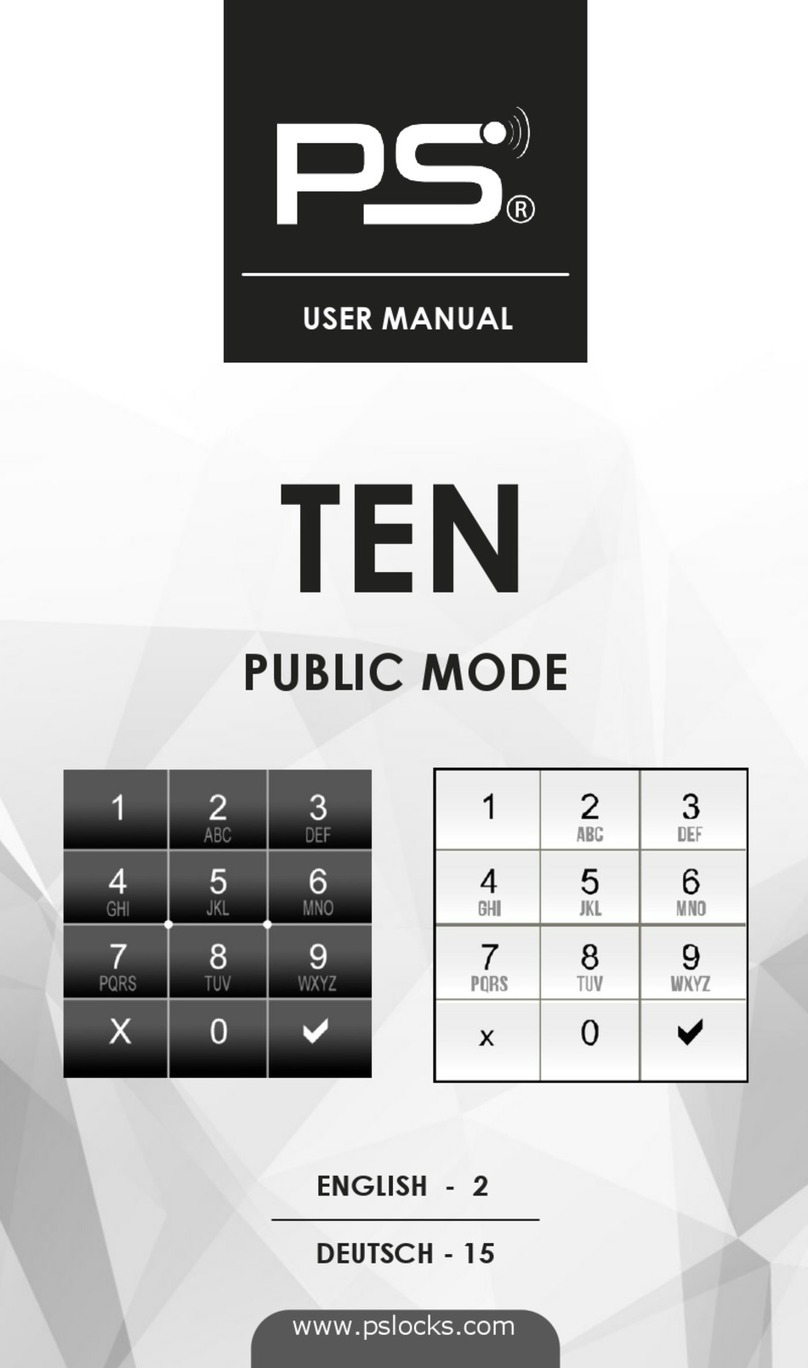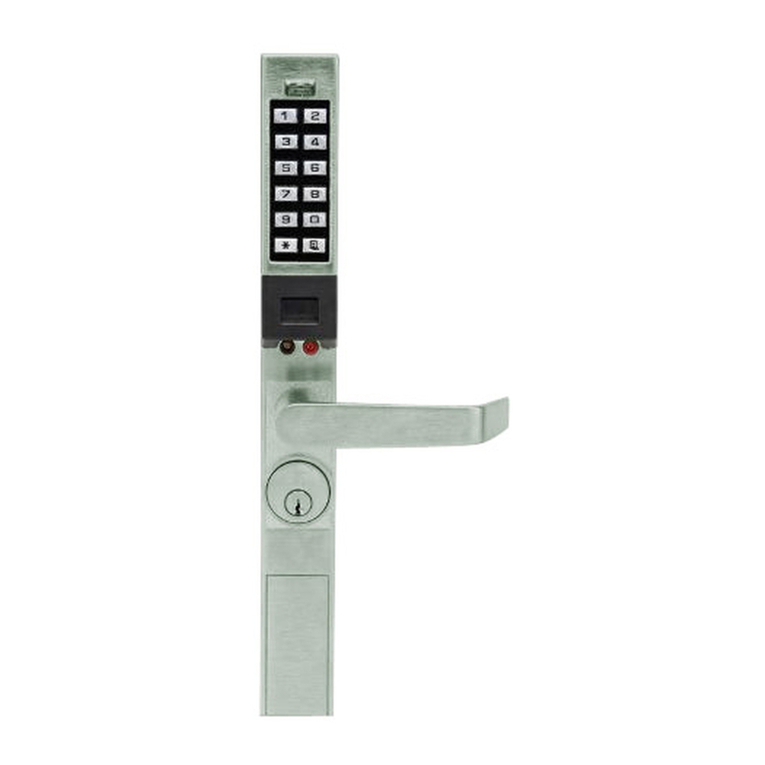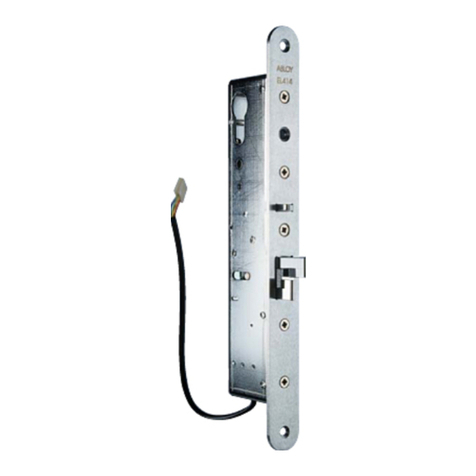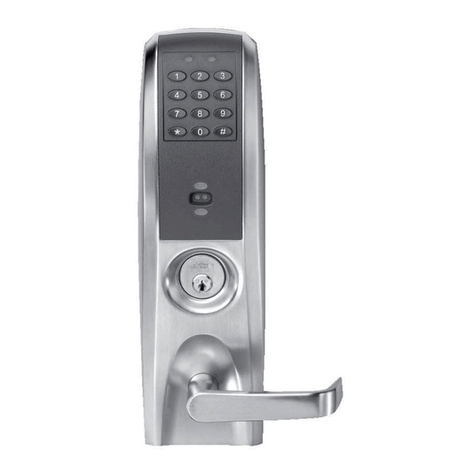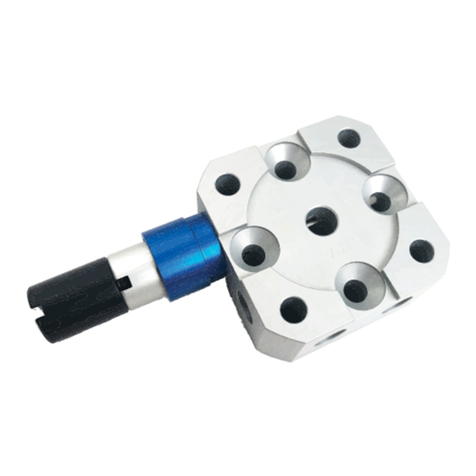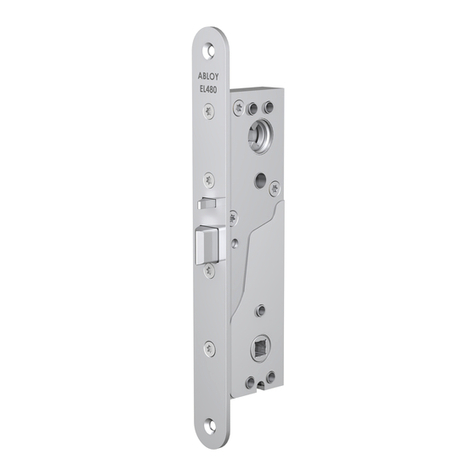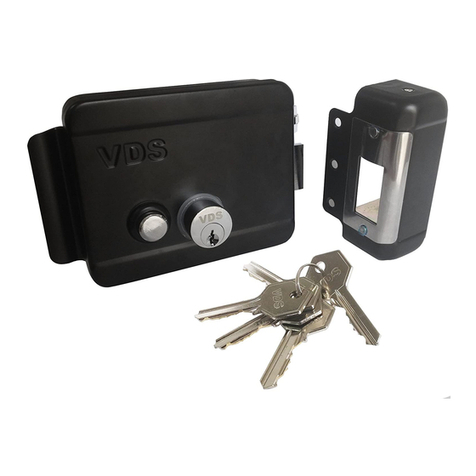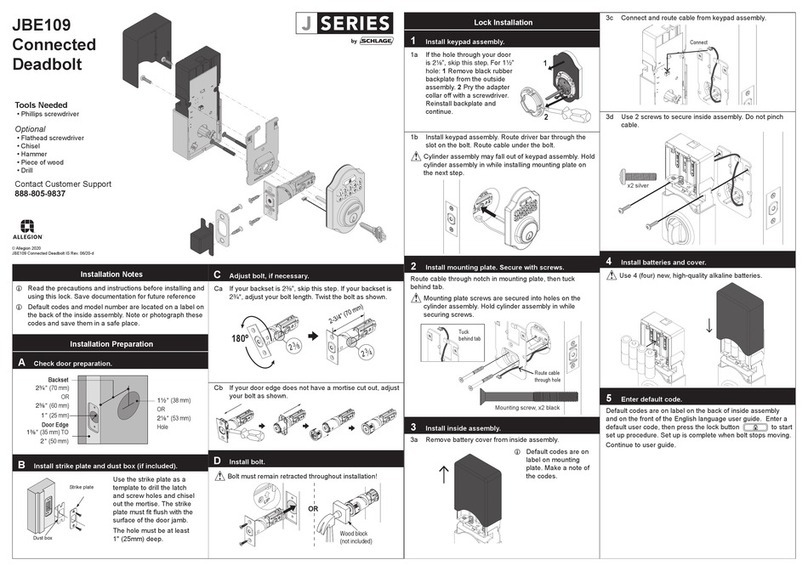Smartlock Digital Axessor CIT User manual


Operating Manual OM_Axessor_CIT_V024_20170518_EN.pdf
Subject to change without prior notice Page 3
Axessor CIT
System overview - Electronic safe lock Axessor CIT
3
2
5
4
1
11
12
10
9
7
8
6
15
14
13
12345678
Type
Part No.
Serial No.
Version
Certs.
Axessor
XXXXXXXXXX
XXXXX.XXXXXX/XXX
xxxxx.xx 2008
VdS
16
18
19
17
21
24
28
22
23
2625
27
29
20

OM_Axessor_CIT_V024_20170518_EN.pdf Operating Manual
Page 4 Subject to change without prior notice
Axessor CIT
Input Unit
1 Housing
2 Connection cable to lock unit
3 Interface (USB) for PC connection
4 <ENTER> key (enter, confirm)
5 <INFO/ESC> key (activate info display or escape/go back to upper
level)
6 Battery compartment
7 <MODE> key (activate Programming Mode)
8 <LEFT> and <RIGHT> key (directional keys to navigate)
9 <0>...<9> (numeric keys 0...9)
10 <DEL> key (delete, close lock)
11 LCD (liquid crystal display)
12 Buzzer
Lock
13 Lock housing
14 Terminal blocks (Inputs/Outputs)
15 Pin for cable tie holder
16 Connecting socket X1 (cable from input unit) and X2 (external power
supply or cable from eBox)
17 Warranty seal
18 Type label
19 VdS-label (protects spring bolt setting screw)
20 External power supply (option)
eBox (Option)
21 Power supply eBox (accessory)
22 eBox connector
23 eBox
24 Fixation supports
25 Network status LEDs
26 RJ45 socket (network connection)
27 Reset opening
28 Connecting sockets (cable to lock unit)
29 eBox status LED

Operating Manual OM_Axessor_CIT_V024_20170518_EN.pdf
Subject to change without prior notice Page 5
Axessor CIT
Content
1 Introduction 10
1.1 To the very beginning 10
1.2 Notes regarding the Operating Manual 10
1.2.1 Validity 10
1.2.2 Target group 10
1.2.3 Limitation 10
1.2.4 Supplementary documentation 10
1.2.5 Symbols used in this operating manual 11
1.2.6 Text marking 11
2 Safety and Environment 12
2.1 General 12
2.2 Qualification of personnel 12
2.3 Prohibited modifications to the unit 12
2.4 Environment 12
3 Product overview 13
3.1 Product description 13
3.2 Field of application 15
3.3 Intended use 15
3.4 Operating modes of the Axessor CIT 15
3.5 System components 18
3.5.1 Axessor CIT lock 18
3.5.2 AS280-INSW activation software 18
3.5.3 AS284-USBW or AS284-NETW programming software 18
3.5.4 AS274 server management software 18
3.5.5 APHI (Application Programming Hardware Interface) 18
4 Installation 19
4.1 Important information prior to the installation 19
4.2 Unpacking and checking the delivery 19
4.3 Installing the Input Unit 20
4.4 Installing the lock 25
4.5 Perform wiring check after lock installation 27
4.6 External connections at the lock 28

OM_Axessor_CIT_V024_20170518_EN.pdf Operating Manual
Page 6 Subject to change without prior notice
Axessor CIT
4.7 Installing the eBox 30
4.8 External connections at the eBox 31
4.9 Perform wiring check after eBox installation 33
5 Operating 34
5.1 Operating and display elements of the Input Unit 34
5.2 Programming mode 35
5.3 Operating modes 35
5.4 Immediate Time Lock 35
5.5 Information menu 36
5.6 Buzzer signals 37
5.7 Status messages 37
5.7.1 Locked (mode S) 37
5.7.2 Locked (mode I) 37
5.7.3 Open (modes S and I) 38
5.7.4 Immediate time lock (modes S and I) 38
5.7.5 Weekly time lock (modes S and I) 38
5.7.6 Holiday time lock (modes S and I) 38
5.7.7 Ready for entry of combination (mode I) 38
5.7.8 Entry of the opening combination (mode I - OTC) 38
5.7.9 Entry of the opening combination (mode I - ICS) 38
5.7.10 The close seal is displayed (mode I) 39
5.7.11 Post-access delay (modes S and I) 39
5.7.12 Opening time delay (mode I) 39
5.7.13 Opening time delay (mode S) 39
5.7.14 Confirmation after elapse of Time Delay (mode S) 40
5.7.15 Enter second code - Dual Mode activated (mode S) 40
5.7.16 Penalty after wrong trials (mode S and I) 41
5.7.17 Remote disabling (mode S and I) 41
5.7.18 Remote enabling (mode S and I) 41
5.7.19 Identification with denied code / Non Return Time Delay enga-
ged (mode S) 41
5.7.20 The battery compartment has been opened (mode S and I) 42
5.7.21 Connected with Programming Software (mode S and I) 42
5.7.22 External power supply available (mode S and I) 42
5.8 Access Codes 43
5.8.1 Code hierarchy and code formats 43
5.8.2 Code types 43
5.8.2.1 Master Code 44
5.8.2.2 Manager Codes 44

Operating Manual OM_Axessor_CIT_V024_20170518_EN.pdf
Subject to change without prior notice Page 7
Axessor CIT
5.8.2.3 User Codes 45
5.8.2.4 Courier Code 46
5.8.3 Shelve Function 46
5.8.4 Duress Code 46
5.8.4.1 Duress Code in bank mode 46
5.8.4.2 Duress Code in interactive mode 47
5.9 Code entry 48
5.10 Opening procedure 49
5.10.1 Opening procedure in bank mode 49
5.10.2 Opening procedure in ICS mode 51
5.10.3 Opening procedure in OTC mode 52
5.11 Closing procedure 53
5.11.1 Closing procedure in bank mode 53
5.11.2 Closing procedure in interactive mode 53
6 Programming Mode 54
6.1 Operating the programming mode 54
6.1.1 Activating the programming mode 54
6.1.2 Navigating in the Programming Mode 55
6.1.3 Modify and save settings in the Programming Mode 55
6.1.4 Exiting the Programming Mode 56
6.2 Menu overview 57
6.3 Access rights 58
6.4 Programming 59
6.4.1 Menu TIME 59
6.4.1.1 Setting the time - submenu TIME 59
6.4.1.2 Setting the time - submenu DATE 60
6.4.1.3 Setting the time format - submenu AM/PM 61
6.4.1.4 Setting the daylight saving time - submenu DST 61
6.4.2 Menu PROG 62
6.4.2.1 Activating an Immediate Time Lock - Submenu IMM-TL 62
6.4.2.2 Configuring Weekly Locking Periods - Submenu WEEKLY 63
6.4.2.2.1 Adding a Weekly Locking Period 63
6.4.2.2.2 Modifying an existing Weekly Locking Period 64
6.4.2.2.3 Deleting an existing Weekly Locking Period 64
6.4.2.3 Configuring Holiday Locking Periods - Submenu HOLIDAY 65
6.4.2.3.1 Adding a Holiday Locking Period 65
6.4.2.3.2 Modifying an existing Holiday Locking Period 66
6.4.2.3.3 Deleting an existing Holiday Locking Period 66
6.4.2.4 Configuring Time Lock interruption - Submenu TL-INT 67
6.4.2.4.1 Adding a
Time Lock interruption 67
6.4.2.4.2 Modifying an existing Time Lock interruption Period 68
6.4.2.4.3 Deleting an existing Time Lock interruption Period 68

OM_Axessor_CIT_V024_20170518_EN.pdf Operating Manual
Page 8 Subject to change without prior notice
Axessor CIT
6.4.2.5 Configuring Time Related Function - Submenu TR-FNC1..3 69
6.4.2.5.1 Adding a Time Related Function 69
6.4.2.5.2 Modifying an existing Time Related Function 71
6.4.2.5.3 Deleting an existing Time Related Function 71
6.4.3 Menu DELAY 72
6.4.3.1 Setting/Deactivating Time Delays - Submenus DELAY 1...4 72
6.4.3.2 Configuring the Confirmation Window - Submenu CNF WIN 74
6.4.3.3 Configuring the Non Return Time delay - Submenu NRTD HM 75
6.4.3.4 Configuring the opening delay of Duress Alarm - Submenu D-
ALARM 75
6.4.3.5 Configuring the Window to enter second code in Dual Mode -
Submenu DUAL bank 76
6.4.3.6 Configuring the Bolt Open Time for bank mode - Submenu BLT
OPN bank 76
6.4.3.7 Configuring the Bolt Open Time for CIT mode - Submenu BLT
OPN cit 77
6.4.3.8 Configuring the Window to enter a one time code - Submenu
PROCTIM cit 78
6.4.3.9 Setting OTM Time Delay - Submenus DELAY cit 78
6.4.3.10 Configuring the opening delay of OTM Duress Alarm - Submenu
DURESS cit 79
6.4.4 Menu CODE 80
6.4.4.1 Changing the Master Code - Submenu MASTER 80
6.4.4.2 Setting Manager Codes - Submenu MANAGER 81
6.4.4.3 Setting User Codes - Submenu USER 82
6.4.4.4 Setting the Courier Code - Submenu COURIER 84
6.4.4.5 Reset the whole Axessor CIT safe lock system to factory def-
aults - Submenu SHELVE 85
6.4.4.6 Modifying a code 86
6.4.4.7 Deleting a code 87
6.4.5 Menu MISC 88
6.4.5.1 Setting the display language - Submenu LANG 88
6.4.5.2 Enabling/disabling Remote Disable - Submenu RMT-DIS 88
6.4.5.3 Setting the Beeper Volume - Submenu Volume 89
6.4.5.4 Enabling/disabling Open Beeper - Submenu OPEN beep 89
6.4.5.5 Enabling/disabling Confirmation Window Beeper - Submenu
CNF WIN beep 90
6.4.5.6 Enabling/disabling Delay Notify Beeper - Submenu DELAY beep
90
6.4.5.7 Enabling/disabling Duress Delay Notify Beeper - Submenu D-
ALARM beep 91
6.4.5.8 Enabling/disabling Wait time display - Submenu WAIT info 91
6.4.5.9 Enabling/disabling Language in display - Submenu LANG info
92
6.4.5.10 Activating/Deactivating Code Denial - Submenu CDE DEN
bank 92
6.4.5.11 Activating/Deactivating Duress Code function -

Operating Manual OM_Axessor_CIT_V024_20170518_EN.pdf
Subject to change without prior notice Page 9
Axessor CIT
Submenu DURESS bank 93
6.4.5.12 Activating/Deactivating Dual Mode - Submenu DUAL bank 94
6.4.5.13 Enabling/disabling One Shot Codes - Submenu ONE SC4 bank
95
6.4.5.14 Enabling/disabling Time Lock for OTM - Submenu TL LOCK cit
96
6.4.5.15 Enabling/disabling Non Return Time Delay - Submenu NRTD cit
96
6.4.5.16 Display the current time - Submenu TIME cit 97
7 Servicing 98
7.1 Cleaning 98
7.2 Replacing the batteries 98
7.3 Customer Service 99
7.4 Spare parts and accessories 100
8 Error messages 101
9 Technical data 104
9.1 Functions 104
9.2 Electronics 107
9.3 Mechanics 108
9.4 Approvals and Certificates 109
9.5 Factory settings 110

OM_Axessor_CIT_V024_20170518_EN.pdf Operating Manual
Page 10 Subject to change without prior notice
Axessor CIT
1 Introduction
1.1 To the very beginning
We thank you for having opted for the Axessor CIT electronic safe lock
with network capabilities.
The Axessor CIT electronic safe lock incorporates the latest technical ad-
vances and meets all recognized safety standards. Nevertheless, improper
use of the Axessor CIT electronic safe lock may result in impairment of
material assets.
To ensure a safe, proper, and economical operation of the Axessor CIT
electronic safe lock, please observe and comply with all information and
safety instructions contained in the present Operating Manual as well as
the instructions given in the manuals for the components used in conjunc-
tion with the safe lock.
If you have questions, which are not or insufficiently answered in this
Operating Manual, please contact your supplier. They will be glad to assist
you.
1.2 Notes regarding the Operating Manual
1.2.1 Validity
This Operating Manual describes the Axessor CIT electronic safe lock.
1.2.2 Target group
This Operating Manual addresses itself to well trained personnel which is
in charge with the installation, the commissioning, the operation, the ser-
vicing and the trouble shooting of the Axessor CIT electronic safe lock.
1.2.3 Limitation
This Operating Manual is restricted to the installation, commissioning,
operation, servicing and trouble shooting of the Axessor CIT electronic
safe lock.
The available options (AS280-INSW Installation Software and AS284-US-
BW or AS284-NETW Programming Software) are only described insofar
as this is necessary for proper operation of the safe lock. Further informa-
tion on the optional software packages can be obtained in the respective
help function of the corresponding software.
1.2.4 Supplementary documentation
This operating manual is supplemented with the Axessor CIT Quick Refer-
ence Guide.

Operating Manual OM_Axessor_CIT_V024_20170518_EN.pdf
Subject to change without prior notice Page 11
Axessor CIT
1.2.5 Symbols used in this operating manual
The following symbols are used in this operating manual to direct your
attention on particular situation, e.g. to indicate a hazardous situation,
requirements which must be met, etc.:
Warning!
Indicates a hazard which can cause damage to the unit or have a serious
effect on the function or use of the unit if unobserved.
Important!
Indicates important information which must be observed during the de-
scribed procedure.
Note!
Indicates notes, information or pointers, which facilitate work or provide
additional background information or point out specific details.
Requirement!
Indicates requirements that must be met for the execution, activation,
modification or deletion of the described function. These requirements
must be met before proceeding.
AS284-USBW or AS284-NETW Programming Software
Refers to the AS284-USBW or AS284-NETW Programming Software (op-
tionally available), which allows additional settings and functions.
1.2.6 Text marking
• The character „“ stands for „see“, „refer to“ or „also consult“
Sample: for a description of Access Code Hierarchy (Code hierarchy
and code formats on page 43).
• Text appearing on the display is marked in capitals and set into quota-
tion marks (sample: „LOCKED“).
• Keys to be used are marked in bold capitals and set into angle brackets:
<DEL> = Delete key
<NUMERIC> = Numeric keys 0…9
<INFO/ESC> = Information/Escape key
<ENTER> = Enter key
<MODE> = Mode key
<LEFT> = Left arrow key
<RIGHT> = Right arrow key

OM_Axessor_CIT_V024_20170518_EN.pdf Operating Manual
Page 12 Subject to change without prior notice
Axessor CIT
2 Safety and Environment
2.1 General
Every person working with the Axessor CIT must have read and under-
stood the operating manual before carrying out any work.
Knowing and understanding the contents of the operating manual is a
basic requirement for protecting the personnel against any kind of danger,
to prevent faulty operation, and to operate the unit safely and correctly.
2.2 Qualification of personnel
All actions described in the present operating manual (installation, com-
missioning, operation, etc.) must be carried out only by well trained and
sufficiently qualified personnel.
For safety and warranty reasons any action beyond the scope of this
manual must be carried out only by qualified personnel authorised by the
manufacturer.
It is assumed that all persons working with the Axessor CIT are familiar
and comply with the appropriate regulations on work safety and the pre-
vention of accidents.
2.3 Prohibited modifications to the unit
Modifications on the Axessor CIT electronic safe lock are explicitly not
recommended, it may void warranty and impair the security and safety of
the unit.
For the replacement of defective components use exclusively original ac-
cessories and spare parts available from your supplier.
2.4 Environment
Packing and consumable material (e.g. batteries) must be disposed of
and/or recycled according to the local regulations.
At the end of the service life the unit and its components must be returned
to the manufacturer or to a collecting point for disposal or recycling ac-
cording to the local regulations.
In case of doubt please contact your supplier.

Operating Manual OM_Axessor_CIT_V024_20170518_EN.pdf
Subject to change without prior notice Page 13
Axessor CIT
3 Product overview
3.1 Product description
The Axessor CIT electronic safe lock is an intelligent motor-bolt lock with
integrated terminals used for instance to connect to an alarm centre. It
features a wide range of functionality, such as a code hierarchy with User
Group management, Courier Code, Dual Mode, Duress Code, Time Delay,
Time Lock functions, Remote Disabling and Code Denial. Additionally there
is the possibility to activate one time code operation for the Axessor CIT
electronic safe lock using the special software AS280-INSW. The operation
and the programming is done via the input unit.
The Axessor CIT electronic safe lock may also be configured with the
AS284-USBW or AS284-NETW Programming Software (optionally avail-
able). This gives access to an even enhanced functionality and allows
customer-tailored solutions to almost every extent.
Unit configuration standard version
In its standard version the Axessor CIT electronic safe lock is battery
powered and consist of: the input unit, the lock and the connection cable.
The lock includes 2 inputs and 2 outputs (assignment External con-
nections at the lock on page 28). Optionally, an external power supply
(6VDC/500mA) can be connected to one of the lock sockets „X1“ or „X2“.
Only use the original Axessor CIT power supply. Even if the external power
supply is connected, the batteries must remain in the battery compart-
ment at all times. They are mainly but not exclusively used in case of a
power failure. Only use non rechargeable AA Alkaline or AA Lithium batter-
ies.
12345678
Type
Part No.
Serial No.
Version
Certs.
Axessor series
XXXXXXXXXX
XXXXX.XXXXXX/XXX
90048.xx
2007
VdS

OM_Axessor_CIT_V024_20170518_EN.pdf Operating Manual
Page 14 Subject to change without prior notice
Axessor CIT
Unit configuration for network integration
Network integration of the Axessor CIT electronic safe lock is established
via the optionally available eBox. The eBox is featuring 5 inputs and 5
outputs, all of them freely configurable. The inputs and the outputs as well
as an external power supply (9 ... 26VDC/700 ... 200mA) are connected
via the eBox connector. The eBox functions, i.e. network connection and
inputs/outputs require an external power supply. In case of a power failure,
the batteries inside the input unit only cover the lock functions, not the
eBox functions.
To set-up and configure the Axessor CIT electronic safe lock for network
integration AS280-INSW Installation software and the AS284-USBW or
AS284-NETW Programming Software are required.
Local Area Network
(10/100BaseT Ethernet)
Safe 1 Safe 2 Safe n
PC with
AS 284-NETW Programming Software
Other devices
12345678
Type
PartNo.
SerialNo.
Version
Certs.
Axessorseries
XXXXXXXXXX
XXXXX.XXXXXX/XXX
90048.xx
2007
VdS
12345678
Type
PartNo.
SerialNo.
Version
Certs.
Axessorseries
XXXXXXXXXX
XXXXX.XXXXXX/XXX
90048.xx
2007
VdS
12345678
Type
PartNo.
SerialNo.
Version
Certs.
Axessorseries
XXXXXXXXXX
XXXXX.XXXXXX/XXX
90048.xx
2007
VdS
Firewall
Router
Internet
12345678
Type
Part No.
Serial No.
Version
Certs.
Axessor series
XXXXXXXXXX
XXXXX.XXXXXX/XXX
90048.xx
2007
VdS

Operating Manual OM_Axessor_CIT_V024_20170518_EN.pdf
Subject to change without prior notice Page 15
Axessor CIT
3.2 Field of application
The Axessor CIT electronic safe lock provides a wide range of functions for
applications in the high security sector. They permit programming of vari-
ous codes and code combinations, time related functions as well as stor-
age and recall of a detailed event log (Audit Trail). Additionally the Axessor
CIT electronic safe lock supports one time code operation.
The programming can be done via the input unit or by connecting a com-
puter running an appropriate Programming Software to the input unit via
USB cable.
This electronic safe lock is especially suitable for applications where high
security, multiple users, traceability and flexibility are required.
3.3 Intended use
The Axessor CIT electronic safe lock serves to block and release the me-
chanical blocking point of a safe, vault, data cabinet, ATM etc. which is
usually activated manually by a bolt work. The Axessor CIT electronic safe
lock can be employed instead of a mechanical combination or key lock. Ap-
plicable regulations and standards have to be observed.
Enabling (lock opening) is only performed upon entry of one or several
codes on the Input Unit. The opening procedure can also be made depend-
ent on time functions and/or external signals.
The Axessor CIT electronic safe lock may only be employed and operated in
accordance with its intended use – blocking and releasing the mechanical
blocking points of above mentioned equipment. Any other type of applica-
tion is explicitly not recommended.
The Axessor CIT electronic safe lock is designed for indoor applications (en-
vironmentally protected areas) – they are not suitable for direct exposure
to environmental impact.
Operation of the equipment in the intended manner requires that all the
information in this operating manual is observed.
3.4 Operating modes of the Axessor CIT
The Axessor CIT electronic safe lock offers three different operating
modes:
– Bank mode (factory setting)
– One time code mode (OTC, ICS, Dual Mode ICS + OTC)
– Mixed mode (bank mode + One time code mode)
Bank mode
Ex factory the Axessor CIT is set to function as a conventional electronic
combination lock. It unlocks after a programmed opening code has been
entered. This mode is called bank mode.

OM_Axessor_CIT_V024_20170518_EN.pdf Operating Manual
Page 16 Subject to change without prior notice
Axessor CIT
One time code mode
Via a activation procedure using the activation software (e.g. AS280-
INSW) the operating mode of the Axessor CIT can be switched to one of
the following one time code modes: ICS (Interactive Code System), OTC
(One Time Combination) or DM (Dual Mode ICS + OTC).
– OTC
In OTC mode the Axessor CIT accepts a generated code from the code
dispatch centre (code dispatch centre with dispatch software) for a sin-
gle opening. This one time code is valid for an unlimited period of time,
but only for a single use. The user identifies himself at the lock with his
4 digits ID.
At the lock Dispatcher software AS274
select user
select lock
generate code
insert ID
insert code
lock opens
lock closed again
close seal insert in SW

Operating Manual OM_Axessor_CIT_V024_20170518_EN.pdf
Subject to change without prior notice Page 17
Axessor CIT
– ICS
The ICS mode ensures that the user is present on-site. First the user
has to identify himself at the lock with his 4 digit ID like in OTC mode.
Then, the lock displays a 6 digit number which must be transmitted to a
dispatch centre to generate an opening code. In contrary to OTC mode
this opening code is valid only for an adjustable period of time.
– DM (Dual Mode)
The Dual mode is a combination of the OTC and ICS modes. The first
user opens the lock in ICS mode in which it is ensured the user is present
on-site. A second user can obtain further codes in OTC mode from the
dispatch centre necessary for the opening procedure.
Mixed mode
Additionally the so called mixed mode can be set via the activation soft-
ware. The mixed mode combines the advantages of the bank mode and
the one time code mode.
The switch between one time code mode to bank mode is done via the
<MODE> key on the lock.
If the lock is in one time code mode “Identif” is shown in the display of the
lock, which prompts the user to enter the 4 digit ID. By pressing on the
<MODE> key the lock switches to the bank mode where the lock status is
displayed (open/closed and time of day). In order to switch to the one time
code mode again the <DEL> key must be pressed.
In mixed mode, the lock can be configured that an one time code can over-
ride a configured Non Return Time Delay NRTD.
At the lock Dispatcher software AS274
select user
select lock
generate code
Enter ID
Display question
close seal insert in SW
insert question
insert code
lock opens
lock closed again

OM_Axessor_CIT_V024_20170518_EN.pdf Operating Manual
Page 18 Subject to change without prior notice
Axessor CIT
3.5 System components
Depending on the size of the system, the number of locks and the number
of operators using the management software, different components are
required. Beside the lock itself, the programming software and the activa-
tion software will always be required. For the operation in interactive
mode (ICS, OTC or Dual mode) additionally a dispatcher software AS274
and an APHI (Application Programming Hardware Interface) is required.
3.5.1 Axessor CIT lock
Axessor CIT consists of a motorized lock with standard dimensions and
an input unit with green navigation buttons. The lock is shipped from the
factory in standard mode with master code 00123456, and functions as a
conventional safe lock.
3.5.2 AS280-INSW activation software
The AS280-INSW activation software for Windows® operating systems is
used to switch from standard mode to interactive mode (ICS, OTC or Dual
mode) and mixed mode. Additionally the AS280-INSW Software is used
for network installation.
3.5.3 AS284-USBW or AS284-NETW programming software
Basic settings for the lock, such as the language, time delays for open-
ing, inputs and outputs, etc., can be configured with the AS284-USBW or
AS284-NETW programming software for Windows® .
3.5.4 AS274 server management software
This practical software makes it possible for a large number of users to
work with the Axessor CIT at the same time. Even the most sophisticated
systems can be managed with this software.
3.5.5 APHI (Application Programming Hardware Interface)
The APHI external interface was developed for the integration of lock
management with a customer’s existing software solution. Once it has
been integrated with existing software, APHI handles all tasks related to
the issuance of one-time combinations.

Operating Manual OM_Axessor_CIT_V024_20170518_EN.pdf
Subject to change without prior notice Page 19
Axessor CIT
4 Installation
4.1 Important information prior to the installation
Warning!
Please observe the following:
• Compliance to described sequence is a necessity. Improper assembly or
different sequence may cause damage to the unit!
• To avoid any damage make sure to keep cables away from moving parts! Do
not lead cables over sharp edges!
• Do not close the safe door until all installation steps have been completed
successfully!
Important!
Please observe the following:
• Removal of or damage to the warranty seal (Template Lock on page 3,
item 17) voids warranty!
• The mounting screws must be secured against loosening, e.g. by using
screw cement, such as LOCTITE 243 (medium, blue).
• Removal of or damage to the VdS label (Template Lock on page 3,
item 19 ) voids VdS approval!
• The lock must not be mounted directly behind lead-throughs! Clog or secure
lead-throughs correspondingly. A suitable cover plate to protect the lock is
available from your supplier (52x DPUL drilling protection plate).
4.2 Unpacking and checking the delivery
Unpack the delivery and check the content of completeness.
The Axessor CIT delivery includes:
• Input Unit
• Lock
• Connection cable
• Plastic bag containing installation material
• 3 batteries AA-size
• Instruction leaflet with further information and reference to home page
The optional eBox is delivered with:
• eBox
• Connection cable
• Plastic bag containing installation material
The optional computer software packages include:
• AS280-INSW: USB cable, 1x Installer dongle (red)
• AS284-USBW: USB cable, 1x Operator dongle (blue)
• AS284-NETW: USB cable, 2x Administrator dongle (orange), 2x Opera-
tor dongle (blue)

OM_Axessor_CIT_V024_20170518_EN.pdf Operating Manual
Page 20 Subject to change without prior notice
Axessor CIT
4.3 Installing the Input Unit
Mounting the base plate
1. Mark either the fixation bores 3 and 5 or 2 and 4 plus bore 1 (recom-
mended). Also mark one of the two bores 6(cable lead-through)
Do so according to the illustration below or by using the template
(Template Input Unit on page 112).
2. Drill the 3 fixation bores Ø3.2 x 14 mm and the cable lead-through bore
Ø10mm. Remove burrs. Tap M4 threads into the 3 fixation bores.
40
41.3
55
10
4 x M4
1
3
2
6
10
6
5
4
193
90

Operating Manual OM_Axessor_CIT_V024_20170518_EN.pdf
Subject to change without prior notice Page 21
Axessor CIT
3. Remove the 3 screws on the bottom of the cover (1 at the battery com-
partment, 2 at the housing). Lift-off the cover from the base plate,
then carefully remove the battery compartment.
4. Fix the base plate with the enclosed special M4x12 flat-head screws
to the door. The Input unit must be fixed to the door with at least two
oppositely positioned screws. The third screw (pos. 1) is recommended.
Table of contents
Other Smartlock Digital Lock manuals
Popular Lock manuals by other brands
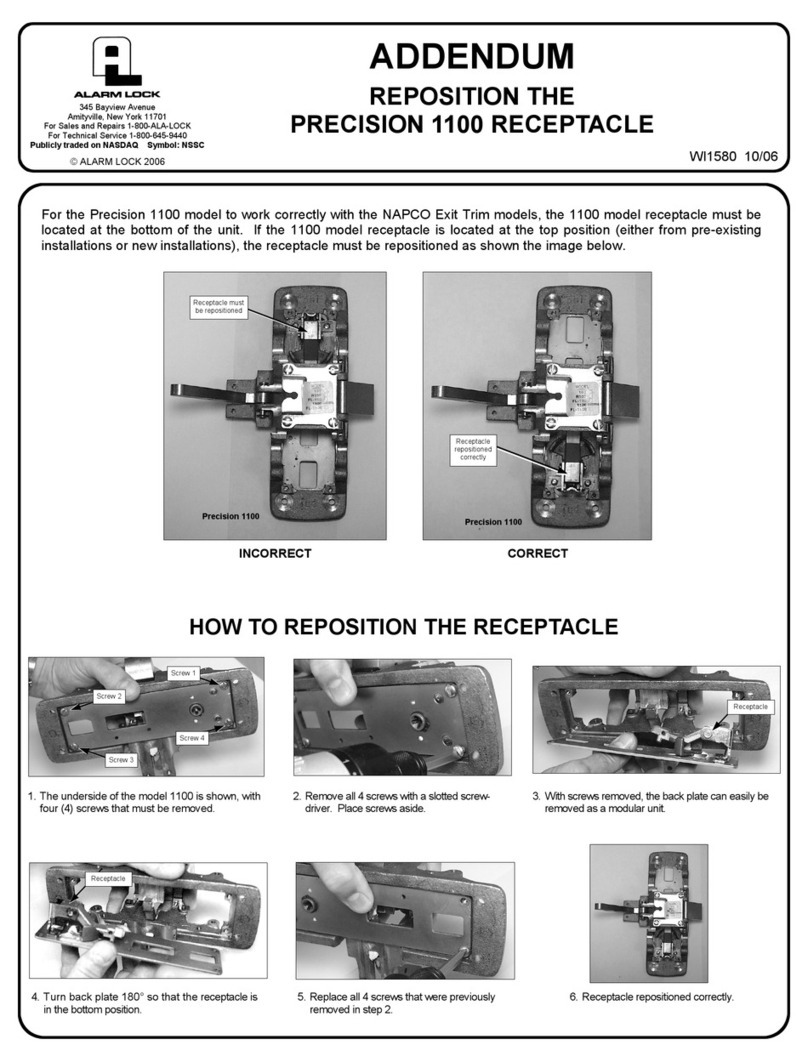
Alarm Lock
Alarm Lock Precision 1100 Addendum manual
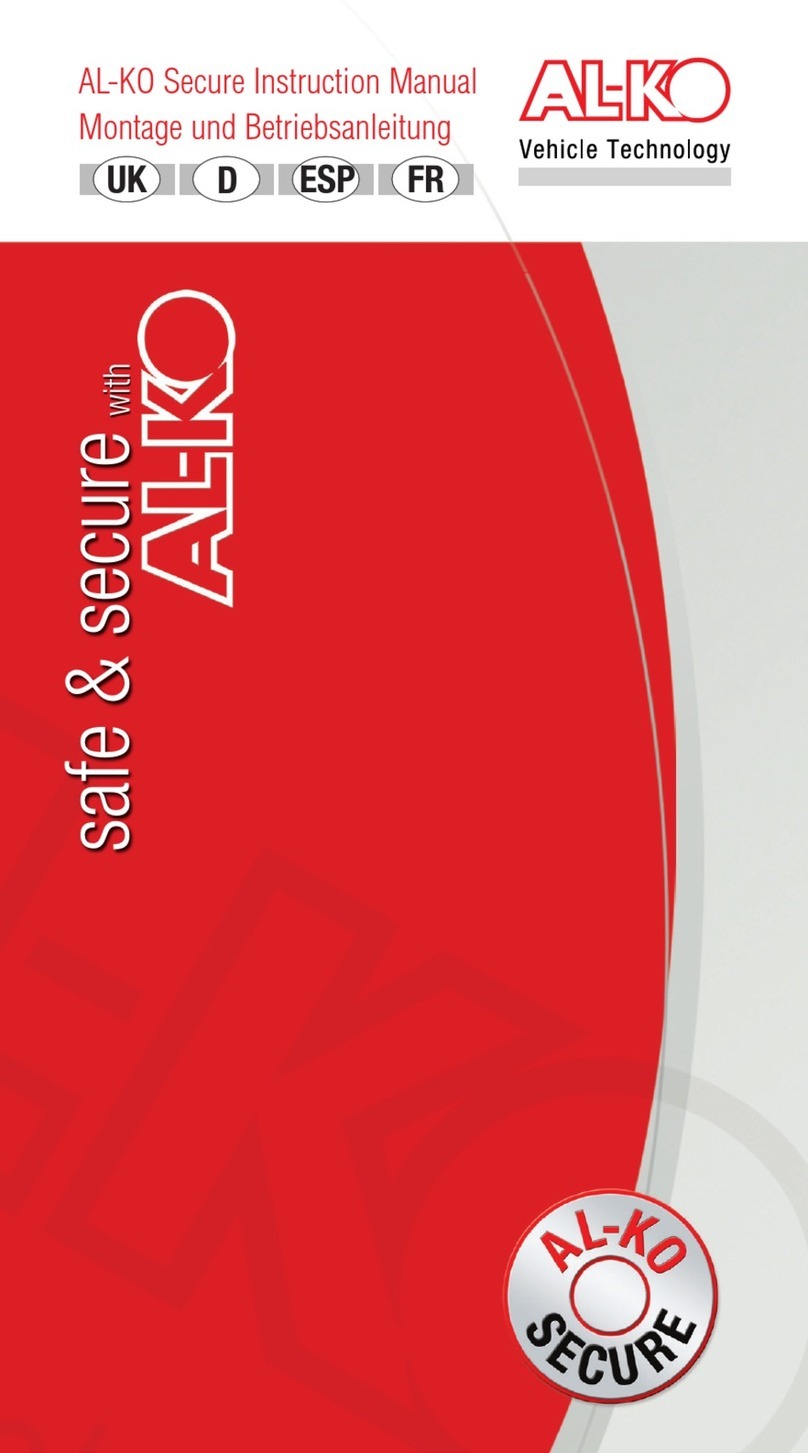
AL-KO
AL-KO Secure Lock instruction manual
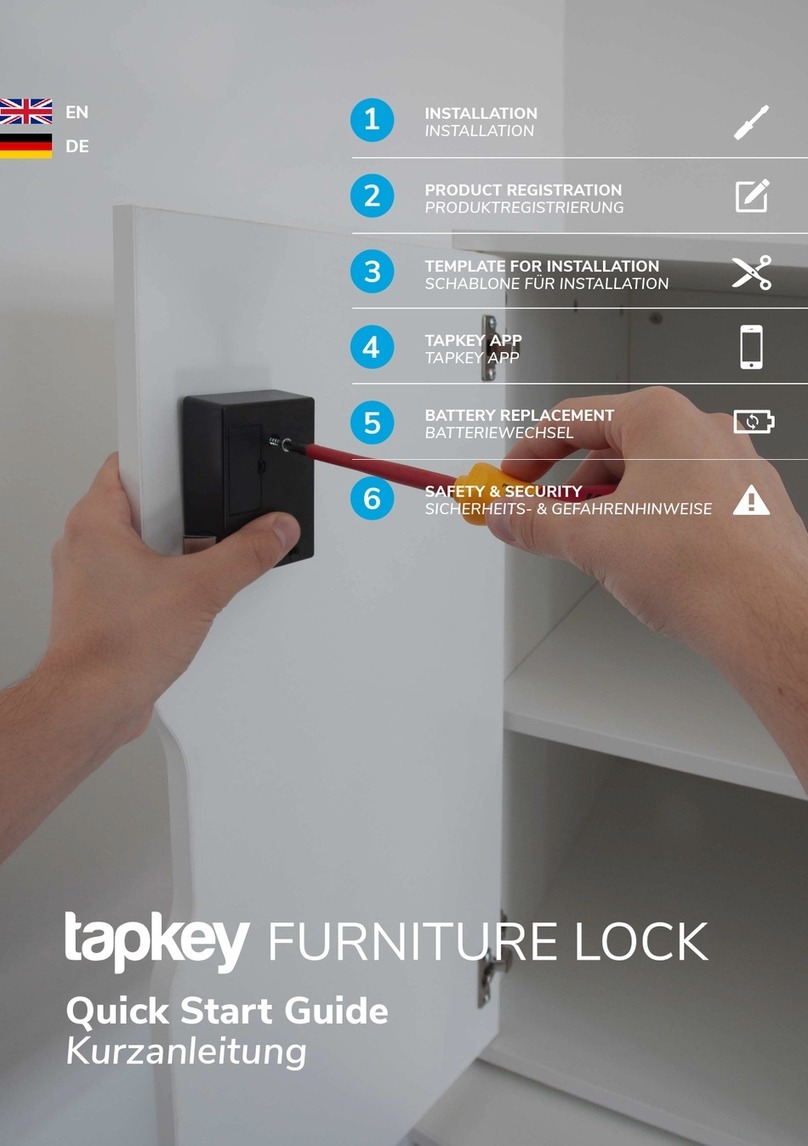
Tapkey
Tapkey Furniture Lock quick start guide
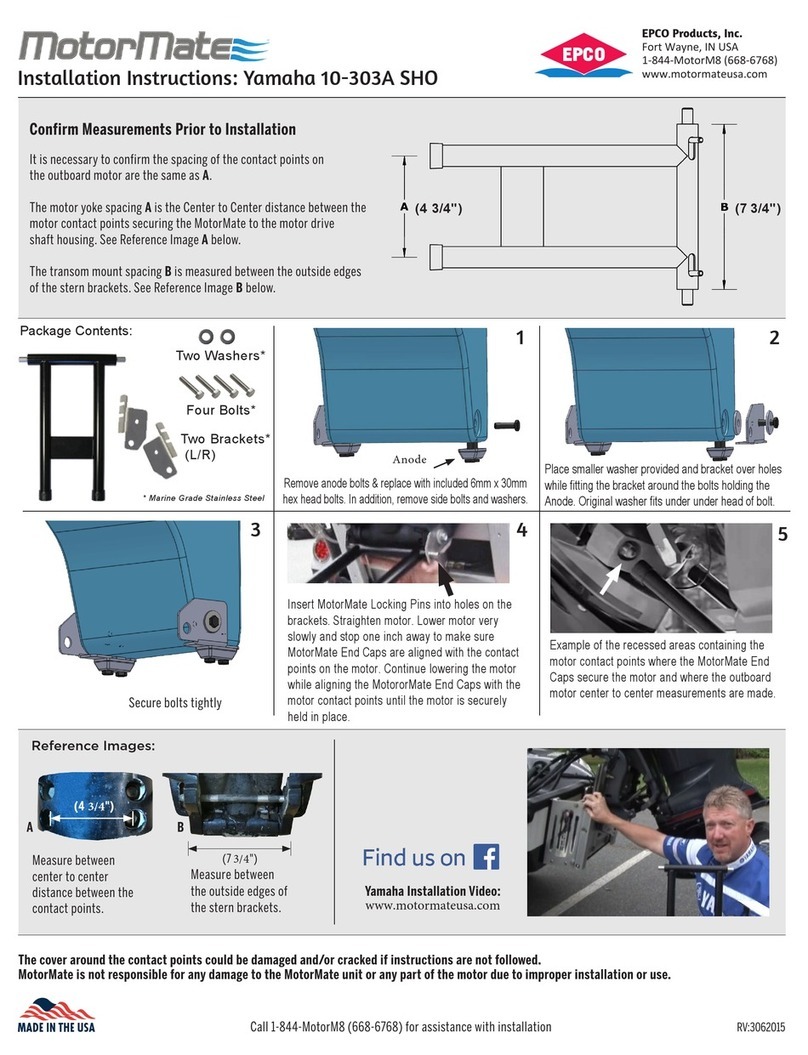
Motormate
Motormate Yamaha 10-303A SHO installation instructions

CENTURION SYSTEMS
CENTURION SYSTEMS D5-EVO Configuration guide

Häfele
Häfele EFL 30 operating instructions
